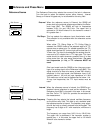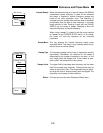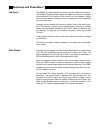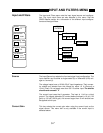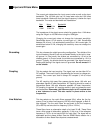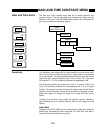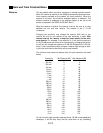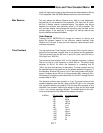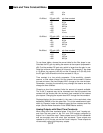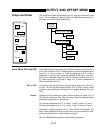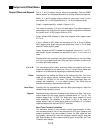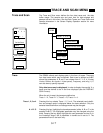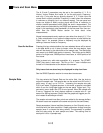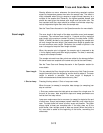
5-12
Gain and Time Constant Menu
<165 10 s
<175 30 s
12 dB/oct DC gain (dB) min time constant
<55 10 µs
<75 30 µs
<95 100 µs
<115 300 µs
<135 1 ms
<155 3 ms
<175 10 ms
18 dB/oct DC gain (dB) min time constant
<62 10 µs
<92 30 µs
<122 100 µs
<152 300 µs
<182 1 ms
24 dB/oct DC gain (dB) min time constant
<72 10 µs
<112 30 µs
<152 100 µs
<182 300 µs
To use these tables, choose the correct table for the filter slope in use.
Calculate the DC gain by adding the reserve to the expand (expressed in
dB). Find the smallest DC gain entry which is larger than the gain in use.
Read the minimum time constant for this entry. For example, if the slope
is 12 dB/oct, the reserve is 65 dB, and the X expand is 10 (20 dB), then
the DC gain is 85 dB and the min time constant is 100 µs.
Time constant is a low priority parameter. If the sensitivity, dynamic
reserve, or filter slope change, and the present time constant is below
the new minimum, the time constant WILL change to the new minimum.
Remember, changing the sensitivity may change the reserve and thus
change the time constant.
Choosing a short time constant limits the amount of expand available.
The X and Y expands may not be increased such that the present time
constant will be shorter than the minimum time constant for the reserve
plus expand. Changing the expand does NOT change the time constant.
Displayed below the time constant in the menu is the equivalent noise
bandwidth (ENBW) of the low pass filter. This is the measurement band-
width for Gaussian noise and depends upon the time constant and filter
slope. (See the Noise discussion in the SR850 Basics section.)
Analog Outputs with Short Time Constants
When using short time constants below 10 ms, the X and Y analog out-
puts from the rear panel or the CH1 and CH2 outputs configured to
output X or Y should be used. These outputs have a 100 kHz bandwidth
and are accurate even with short time constants. Trace outputs are
updated at a 512 Hz rate, as are the R and θ outputs. These outputs do
not accurately reflect high frequency outputs.



